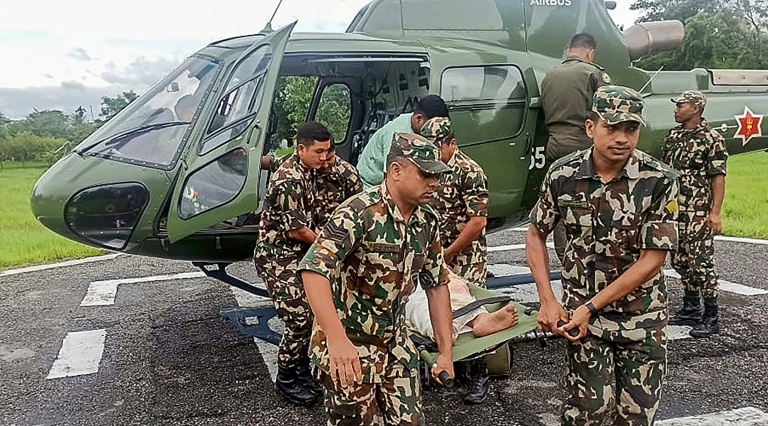World
Torrential Rains in Nepal and India Claim 63 Lives, Wreak Havoc

Severe landslides and floods resulting from heavy rainfall have led to the tragic deaths of at least 63 people across Nepal and India. The disasters unfolded over the weekend, with officials reporting widespread destruction and significant challenges in reaching affected areas.
In Nepal, torrential downpours have persisted since September 29, 2023, causing rivers to swell and inundate numerous communities. According to Shanti Mahat, spokeswoman for Nepal’s National Disaster Risk Reduction and Management Authority, at least 43 fatalities have been confirmed, with five individuals still missing. The eastern district of Illam, which has experienced the most severe impact, has reported 37 deaths due to landslides.
“Heavy rains overnight caused the landslides,” stated local district official Sunita Nepal. “With roads blocked, some areas are difficult to reach. Rescue workers are heading there on foot.” In Kathmandu, rising river levels have inundated settlements along their banks, prompting the deployment of security personnel to aid in rescue operations using helicopters and motorboats.
Local resident Rajan Khadga, a vegetable seller, noted, “There is some damage, but thanks to the authorities’ prior flood alert, we were able to move some belongings to a safe place.” The relentless rains have disrupted highways and delayed flights, leaving many travelers stranded, particularly those returning from the Hindu festival of Dashain.
In response to the crisis, Prime Minister Sushila Karki assured the public that government agencies are “fully prepared for rescue and relief.” She announced that Sunday and Monday would be declared public holidays, urging citizens to refrain from unnecessary travel.
Across the border in India, the situation is similarly dire. At least 20 people have lost their lives in the tea-growing district of Darjeeling in West Bengal due to flash floods and landslides triggered by overnight rainfall. Lawmaker Harsh Vardhan Shringla confirmed the fatalities, stating, “In the wake of last night’s heavy cyclone in the Darjeeling hills, over 20 people have lost their lives.”
Rescue footage broadcast on Indian television shows workers using cables to access isolated regions as torrents of water wreak havoc on infrastructure. Prime Minister Narendra Modi expressed his condolences in a social media statement, indicating that he is closely monitoring the situation in Darjeeling and surrounding areas.
The annual monsoon season, which typically spans from June to September, has historically resulted in widespread devastation across South Asia. However, the frequency and intensity of fatal floods and landslides have escalated in recent years, a trend that experts attribute to climate change.
The Kathmandu-based International Centre for Integrated Mountain Development warned earlier this year that communities might face increased disaster risk during the current monsoon season. “Rising temperatures and more extreme rain raise the risk of water-induced disasters such as floods, landslides, and debris flows,” the organization stated in June.
As rescue efforts continue, the full extent of the damage remains unclear, but the loss of life and the impact on communities in both Nepal and India highlight the urgent need for effective disaster management strategies in the face of changing climate conditions.
-

 Science3 months ago
Science3 months agoToyoake City Proposes Daily Two-Hour Smartphone Use Limit
-

 Top Stories3 months ago
Top Stories3 months agoPedestrian Fatally Injured in Esquimalt Collision on August 14
-

 Health3 months ago
Health3 months agoB.C. Review Reveals Urgent Need for Rare-Disease Drug Reforms
-

 Technology3 months ago
Technology3 months agoDark Adventure Game “Bye Sweet Carole” Set for October Release
-

 World3 months ago
World3 months agoJimmy Lai’s Defense Challenges Charges Under National Security Law
-

 Lifestyle3 months ago
Lifestyle3 months agoVictoria’s Pop-Up Shop Shines Light on B.C.’s Wolf Cull
-

 Technology3 months ago
Technology3 months agoKonami Revives Iconic Metal Gear Solid Delta Ahead of Release
-

 Technology3 months ago
Technology3 months agoApple Expands Self-Service Repair Program to Canada
-

 Technology3 months ago
Technology3 months agoSnapmaker U1 Color 3D Printer Redefines Speed and Sustainability
-

 Technology3 months ago
Technology3 months agoAION Folding Knife: Redefining EDC Design with Premium Materials
-

 Technology3 months ago
Technology3 months agoSolve Today’s Wordle Challenge: Hints and Answer for August 19
-

 Business3 months ago
Business3 months agoGordon Murray Automotive Unveils S1 LM and Le Mans GTR at Monterey









